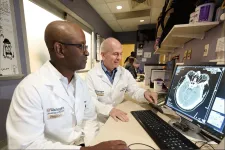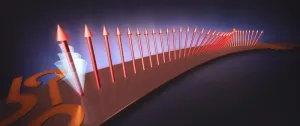(Press-News.org) Fruit flies walking on miniature treadmills are helping scientists learn how the nervous system enables animals to move in an unpredictable and complex world.
Insights from using these fruit fly-sized treadmills were reported Aug. 30 in Current Biology, a Cell Press journal. Several videos of the flies running on the treadmills are available for viewing on the online research paper. The lead author is Brandon G. Pratt, a recent physiology and biophysics Ph.D. graduate of the University of Washington School of Medicine in Seattle and a National Science Foundation Graduate Research Fellow.
He engineered the small-scale machines from inexpensive parts, based on a prototype from Max Mauer, a UW mechanical engineering alumnus.
Pratt and his research colleagues explained that walking animals, including insects and people, must recognize and rapidly deal with unexpected changes underfoot. If an animal were unable to do so, navigating the world would be nearly impossible and injury from falls would be likely.
How does the nervous system detect these unexpected events and control the body to regain balance during locomotion? That question is being explored in John Tuthill’s laboratory at the UW Department of Physiology and Biophysics, where Tuthill is an associate professor and Pratt conducted his doctoral research. Lab colleagues Su-Yee J. Lee and Grant M. Chou also contributed to this project.
Tuthill’s lab studies proprioception: how the body continually senses its articulation and movement. Illness, injury, and other factors can interfere with the ability of people and animals to coordinate their bodies and hinder simple tasks like grabbing a glass of water or walking a couple of feet.
Investigating how proprioception controls the body when it becomes off kilter during locomotion is a fundamental challenge for neuroscientists. Experimental disruptions to proprioception can curb animal behaviors and thereby confound efforts to examine proprioception’s role in natural activities like walking.
Historically, treadmills have effectively reignited animals’ desire to walk after perturbations to the nervous system. Treadmills have helped to provide insight into the neural control of walking and running with invertebrates (animals without backbones) like cockroaches and stick insects, as well as vertebrates like rodents, cats, and humans.
Split-belt treadmills have two belts that move independently. Researchers use them to investigate how the coordination between the legs adapts when the legs on the left side of the body move at a different speed than those on the right. These treadmills have played a clinical role in evaluating stroke patients.
Both types of treadmill systems inspired researchers in the Tuthill lab to engineer miniature versions to study locomotion in fruit flies. These tiny creatures are a good model system to study the neural control of locomotion because they have a compact, fully mapped nervous system. Moreover, a suite of genetic tools enables scientists to perform precise and specific manipulations of the fly nervous system.
The linear treadmill system in Tuthill’s lab coerces flies to walk and allows for long-term 3D tracking. The researchers were able to analyze walking across various speeds in flies with and without impaired proprioception.
On the treadmill, flies walked in bursts, sprinting to the front of the treadmill chamber, and then rode the belt to the back. They spent roughly half their time walking. They would speed up when the belt did. Just as with humans and cockroaches, their body height rose when they walked faster. By using the treadmill in their experiments, the researchers obtained the fastest walking speed ever reported for fruit flies.
“They were able to surpass an instantaneous walking speed of 50 millimeters per second,” the researchers noted.
The researchers also genetically silenced neurons underlying proprioception and ran the insects on the linear treadmill. Without this sensory feedback, flies took fewer but larger steps. Surprisingly, the coordination of their legs did not seem to be affected — perhaps because other proprioceptive neurons are more important to coordinate walking, or the nervous system may have compensated for the lack of feedback.
The scientists found that the split-belt treadmill had little effect on the coordination between legs. However, flies substantially changed the step distances of their middle legs when the two belts moved at different speeds. The researchers suggest that flies modify their steps to continue walking straight in the presence of rotational perturbations.
“The middle legs are ideally positioned to stably pivot the body of the fly about its center of mass, like rowing a boat from its center,” the researchers explained.
The scientists noted that, “These insights illustrate how treadmills fill an important gap between free-walking and tethered preparations for investigating neural and behavioral mechanisms for fly locomotion.”
The researchers have provided the software and hardware designs of these miniature treadmill systems as a free, open source for fellow scientists.
The research was supported by a National Science Foundation Graduate Research Fellowship 2018261272, National Institutes of Health grants T32 NS 99578-3, R01NS102333, and U19NS104655, Searle Scholar Award, Klingenstein-Simons Fellowship, Pew Biomedical Scholar Award, McKnight Scholar Award, Sloan Research Fellowship, the New York Stem Cell Foundation, and a UW Innovation Award. Tuthill is a New York Stem Cell Foundation Robertson Investigator.
END
Miniature treadmills accelerate studies of insects walking
Scientists engineer tiny linear and split-belt treadmills to understand how flies walk
2024-09-04
ELSE PRESS RELEASES FROM THIS DATE:
UTA undergraduate researcher receives national honors
2024-09-04
A physics student at The University of Texas at Arlington studying ways to measure the mass of tiny particles called neutrinos has earned a prestigious national award for her research.
Senior Kara Stogsdill received the Outstanding Undergraduate Research Award from the Society of Physics Students, an organization of the American Institute of Physics. The award is given to students based on exceptional research achievements in any physics-related field.
Stogsdill’s research is part of the Project 8 Neutrino Mass Experiment, which includes faculty and students from UTA and 13 other universities and national laboratories ...
Pennington Biomedical's Greaux Healthy Initiative takes aim at childhood obesity
2024-09-04
Pennington Biomedical Research Center is formally launching Greaux Healthy, a public service initiative designed to help improve kids’ health at every age. Developed with funding from the State of Louisiana, Greaux Healthy implements 35 years of Pennington Biomedical research and discoveries to inform tools, resources and programing for children, parents, physicians and educators throughout the state.
The Greaux Healthy initiative is developing a wide variety of educational materials distinctly tailored to four priority populations, including expectant families and parents of infants, ...
Millions of people with diabetic foot ulcers could benefit from new research discovery
2024-09-04
Highlights:
Researchers from Michigan State University and South Shore Hospital in Massachusetts have uncovered a connection between two common diabetes drugs — insulin and metformin — identified in wound exudates of diabetic foot ulcers, which may improve their healing.
While analyzing wound exudate (the fluid the body moves and secretes to the site of an injury), researchers discovered the presence of metformin in patients who take the drug orally.
The researchers then explored metformin’s relationship ...
Adding anti-clotting drugs to stroke care ineffective, clinical trial finds
2024-09-04
Stroke patients who survive a blood clot in the brain’s blood vessels are prone to developing new blockages during their recovery periods, even if they receive vessel-clearing interventions. In an effort to avoid further clots, doctors at 57 sites around the U.S. tested a possible solution: the addition of anti-coagulant drugs to medicine that dissolves blood clots.
But results from the clinical trial, led by Opeolu Adeoye, MD, head of the Department of Emergency Medicine at Washington University School of Medicine in St. Louis, indicate two such drugs did not improve outcomes.
The findings are available Sept. 4 in The New England Journal ...
Research Center awarded $14.4 million to advance new manufacturing solutions for microelectronics
2024-09-04
A new Energy Frontier Research Center (EFRC), supported by the Department of Energy’s Office of Science and led by SLAC National Accelerator Laboratory, was awarded $14.4 million over four years to advance manufacturing of microelectronics by investigating approaches to building their components in fundamentally new ways.
Instead of moving electrons through conducting metallic interconnects in the miniscule and ever shrinking parts of devices such as microchips used in computers and cell phones, the researchers propose to move information via spin waves that can propagate through semiconductors ...
Notre Dame researchers create new tool to analyze embodied carbon in more than 1 million buildings in Chicago
2024-09-04
The built environment — which includes the construction and operation of buildings, highways, bridges and other infrastructure — is responsible for close to 40 percent of the global greenhouse gas emissions contributing to climate change.
While many building codes and benchmarks have focused on constructing “greener,” more energy-efficient new buildings, it is not enough to seek to reduce emissions in operations, said Ming Hu, the associate dean for research, scholarship and creative work in Notre Dame’s School of Architecture. Rather, policymakers and industry leaders ...
SMU researcher helps develop new technique to explore oceanic microbes
2024-09-04
DALLAS (SMU) – When SMU researcher Alexander Chase was a young boy, the sheer diversity of plants in Earth’s tropical rainforests fascinated him. He found himself wondering, what new species were out there, waiting to be unearthed? That curiosity is why Chase now collects samples from Earth’s oceans using a new technique called Small Molecule In situ Resin Capture (SMIRC), which could be the first step in uncovering compounds that lead to next-generation antibiotics.
Microbial natural products come from microorganisms, or microbes, and account for many of today’s essential medicines, including most antibiotics. Microbes are too small to see without ...
New guideline for Helicobacter pylori includes change to primary treatment recommendation
2024-09-04
The American Journal of Gastroenterology has published a new guideline on the treatment of Helicobacter pylori (H. pylori) infection.
The corresponding author on the guideline is William D. Chey, M.D., chief of the Division of Gastroenterology and Hepatology at Michigan.
H. pylori is a bacterium that infects over half the people in the world, though most are asymptomatic.
It can cause dyspepsia, peptic ulcer disease and gastric cancer.
This latest clinical practice guideline notes that its prevalence in North America is decreasing, but it still infects 30-40% of the population.
A previous guideline ...
Making desalination more efficient, by way of renewable energy
2024-09-04
(Santa Barbara, Calif.) — With freshwater becoming an ever scarcer resource, desalination of ocean water is increasingly employed to bridge the gap between supply and demand. However, desalination is energy-intensive, often powered by fossil fuels, so meeting the need for freshwater can exacerbate the challenge of reducing atmospheric CO2, the main driver of climate change.
Yangying Zhu, an assistant professor in the Department of Mechanical Engineering at UC Santa Barbara, wants to address that conundrum. Now, a two-year, $500,000 seed grant from the Advanced Research Projects Agency-Energy (ARPA-E) ...
Preventing car battery fires with help from machine learning
2024-09-04
One of the most critical safety concerns for electric vehicles is keeping their batteries cool, as temperature spikes can lead to dangerous consequences.
New research led by a University of Arizona doctoral student proposes a way to predict and prevent temperature spikes in the lithium-ion batteries commonly used to power such vehicles.
The paper "Advancing Battery Safety," led by College of Engineering doctoral student Basab Goswami, is published in the Journal of Power Sources.
With the support of $599,808 from the Department of Defense's Defense Established Program to Stimulate Competitive Research, Goswami and his adviser, aerospace ...
LAST 30 PRESS RELEASES:
Global psychiatry mourns Professor Dan Stein, visionary who transformed mental health science across Africa and beyond
KIST develops eco-friendly palladium recovery technology to safeguard resource security
Statins significantly reduce mortality risk for adults with diabetes, regardless of cardiovascular risk
Brain immune cells may drive more damage in females than males with Alzheimer’s
Evidence-based recommendations empower clinicians to manage epilepsy in pregnancy
Fungus turns bark beetles’ defenses against them
There are new antivirals being tested for herpesviruses. Scientists now know how they work
CDI scientist, colleagues author review of global burden of fungus Candida auris
How does stroke influence speech comprehension?
B cells transiently unlock their plasticity, risking lymphoma development
Advanced AI dodel predicts spoken language outcomes in deaf children after cochlear implants
Multimodal imaging-based cerebral blood flow prediction model development in simulated microgravity
Accelerated streaming subgraph matching framework is faster, more robust, and scalable
Gestational diabetes rose every year in the US since 2016
OHSU researchers find breast cancer drug boosts leukemia treatment
Fear and medical misinformation regarding risk of progression or recurrence among patients with breast cancer
Glucagonlike peptide-1 receptor agonists and asthma risk in adolescents with obesity
Reviving dormant immunity: Millimeter waves reprogram the immunosuppressive microenvironment to potentiate immunotherapy without obvious side effects
Safety decision-making for autonomous vehicles integrating passenger physiological states by fNIRS
Fires could emit more air pollution than previously estimated
A new way to map how cells choose their fate
Numbers in our sights affect how we perceive space
SIMJ announces global collaborative book project in commemoration of its 75th anniversary
Air pollution exposure and birth weight
Obstructive sleep apnea risk and mental health conditions among older adults
How talking slows eye movements behind the wheel
The Ceramic Society of Japan’s Oxoate Ceramics Research Association launches new international book project
Heart-brain connection: international study reveals the role of the vagus nerve in keeping the heart young
Researchers identify Rb1 as a predictive biomarker for a new therapeutic strategy in some breast cancers
Survey reveals ethical gaps slowing AI adoption in pediatric surgery
[Press-News.org] Miniature treadmills accelerate studies of insects walkingScientists engineer tiny linear and split-belt treadmills to understand how flies walk







